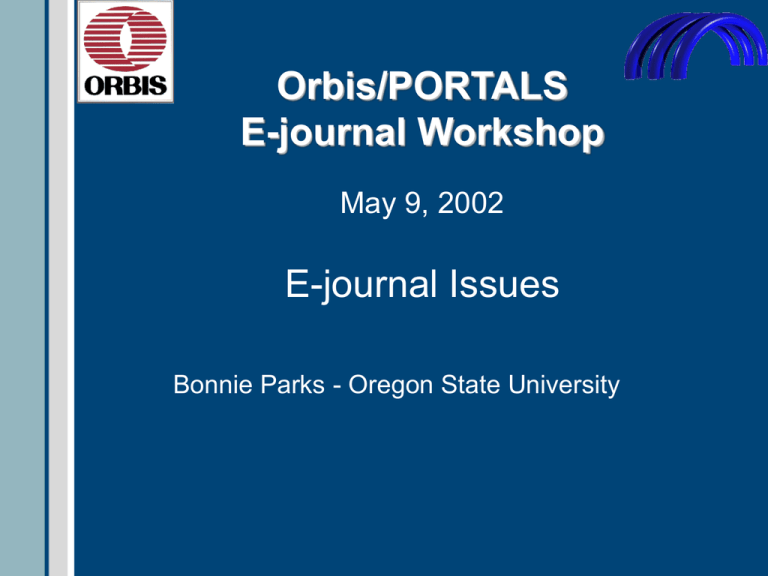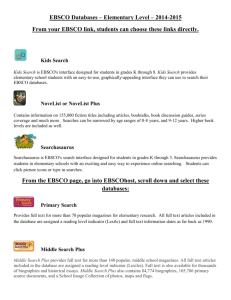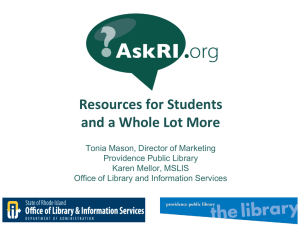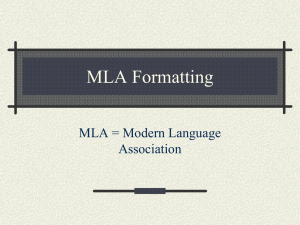Orbis/PORTALS E-journal Workshop E-journal Issues May 9, 2002
advertisement

Orbis/PORTALS E-journal Workshop May 9, 2002 E-journal Issues Bonnie Parks - Oregon State University Aggregations and Packages What kinds of e-serial aggregations and packages are available? How can libraries provide access to titles and content in these packages? What are Aggregations? (aka Aggravations) • A collection of publications in electronic form, commonly full-text versions of print journals. • Some aggregations are stable and well maintained (e.g. Project Muse, JSTOR) • Some are of the “31 Flavors” variety (e.g. Lexis/Nexis, Bell + Howell (Proquest)) Stable Aggregations • Have a common element (usually publisher or subject) • Have complete full text (or, if not complete, differences are made clear) • Articles are accessible by journal title and issue • Stable title list (often aggregator notifies subscriber of changes or additions to collection) • Close correspondence between print and online (makes cataloging relatively easy) Stable Aggregation : JSTOR “31 Flavors” • Large, amorphous collections • Titles come and go (what’s available today might not be available next month) • Users frequently cannot designate specific journal title and issue • Often lack full text of a journal or some issues of a particular journal 31 Flavors example : LexisNexis How Do You Provide Access to the various Electronic Journal Packages in Your Library? • • • • Catalog them and make available in OPAC? A-Z list of journal titles? Separate database? Other means? Sample E-journal Catalog Record Sample A-Z E-journal List Aggregators and the OPAC • The library catalog should provide users with a record of all selected and available material regardless of format • Users tend to expect aggregator database titles to appear in the OPAC • Conventional cataloging could solve problems of aggregations, but most cataloging departments do not have the resources to provide this access) Aggregator Access In addition to access via the OPAC, consider alternative means – Through web lists, databases and gateways – Through online indexes and databases Access : Traditional Cataloging Titles individually cataloged following the same procedures as for other serials Advantages • Benefits of complete MARC records (authorized subject headings, names, classification) • Consistency within the catalog • Cataloging copy often available for larger packages Access : Traditional Cataloging Disadvantages – Cataloging e-serials can be more timeconsuming than cataloging print – Since e-resources are prone to change, more record maintenance is needed than with print (and you thought maintaining print serials was a lot of work!) Access : Single-Record Approach The single-record approach notes the existence of an online version on the record for the print serial Advantages – Complete print serial records (authorized subject headings, names, classification) – Doesn’t require a lot of cataloging expertise to add access points for online version – Large packages can be processed with less work on each title. Example of Single-Record Approach Access : Single-Record Approach Disadvantages – Cataloging is still required for titles not held in print collection – Loss of access points unique to electronic version • have the option of adding it locally, but that, too, requires maintenance (e.g. Adding 710 JSTOR (Organization) to all your JSTOR titles) – Still difficult to keep up with maintenance in dynamic aggregators like Bell + Howell, Ebsco, etc. Access : Aggregator Record Sets •MARC record sets are available from several sources, e.g. OCLC (Worldcat), Bell + Howell (Proquest), Ebsco •Commercial services are developing customized MARC record sets for a variety of packages Considerations when looking into record sets • • • • • Record completeness Maintenance and updates Cost Relation to records already in your catalog Ease of removing records from your local system If your library’s subscription to 3,000 EBSCO titles is cancelled today, how will get those records and links out of your catalog tomorrow? Some Questions to Ask • How complete and authoritative are the records? – E.g. Ebsco derives records from CONSER records, so generally, the records are complete and authoritative – Gale generates their records from their own data, which doesn’t include authorized headings or complete description. • Are record updates distributed? How frequently? Is there an added cost? Per record? Per set? Per load? • Is the entire record set redistributed or only records to be deleted, added or changed? Maintenance and cost issues here! Access : Journal Title Lists “In the beginning ...” users accessed e-journals through alphabetic lists on web pages These lists still are popular, though now there are more and more titles to maintain! Some libraries are unable to provide online access through the catalog, so A-Z lists continue to be be an option Example of E-journal Database that Generates Web Pages (Scripps Research Institute) Access : Separate Database Some libraries have created a separate database of their aggregator e-journal coverage Advantage •Requires no cataloging resources Disadvantages •Users must consult two sources to determine journal holdings •Still subject to maintenance •Individual libraries must do the work themselves •Potentially no subject or corporate body access Example of Comprehensive Database JAKE is probably one of the more well-known early databases. Access : Local Scripting What is it? Minimal records are created by the library from vendor-supplied title/ISSN listing Advantage •Provides online access to large packages for which no record set is available Disadvantages •Libraries must do the work themselves •Vendor-supplied lists usually don’t include OPAC access points (subject, corporate body) or title history •If ISSN isn’t available, it’s tough to match records Local Scripting and OSU : the Ebsco Records Wizard What is it? – GUI-based collection of vbscripts created by Terry Reese What does it do? – Provides access to individual Ebsco titles – De-dups the Ebsco Records sets on OCLC number and ISBN – Generates a new overlay point – Provides a method to globally add/delete fields. Ebsco Records Wizard: Getting Help The Ebsco Records Wizard uses a web-based help system. – System facilitates local use and remote use. Help system and the program can be downloaded from: http://ucs.orst.edu/~reeset/ebsco/html/ Service Benefits : a comparison April 2001 and April 2002 were used as a test month for comparison. Based on usage stats from these two months, Ebsco usage increased by approximately 70%. 15000 10000 Apr-01 Apr-02 5000 0 Logins Service Benefits: a comparison Moreover, including titles in the OPAC decreased the amount of patron time needed to spend searching for a resource. Again, using the same two test months, one can see that they amount of searches performed on the database actually went down 25%. This is due largely to the fact that users are being taken directly to their desired journal, rather then having to search each individual subscription database for the Journal title. 40000 30000 Apr-01 Apr-02 20000 10000 0 Searches Service Benefits: a comparison cont. In addition to decreased searching on EBSCO, we can see that many of the new users coming to EBSCO are coming through Oasis. Again, using out two test months, we can see that once the EBSCO records were provided in the OPAC, they were immediately utilized. 6000 4000 Apr-01 Apr-02 2000 0 Searches Accessing Ebsco Records Ebsco Titles are now accessible directly through the library’s OPAC! On the right: an author search in the OPAC. Using this search, a patron can locate all the Ebsco titles currently in the local catalog. Accessing Ebsco Records cont. All Ebsco records are – Searchable within an electronic resources scope – Are noted with [electronic resource] in the GMD for easy identification Accessing Ebsco Records cont. Accessing titles via the catalog: Other Means of Access : Vendor Solutions Vendor solutions cover a wide range of possibilities including: • • • • • Printed lists Title and holdings data Record sets Searchable tables of contents Management information Aggregations : Summary • There are many ways to provide access to serials in packages and aggregations • Depending on the packages your library uses, there might be one solution or several solutions • Libraries should include catalog access but also should think beyond the catalog • It’s all about ACCESS! Suggested Reading Li, Yiu-On and Shirley W. Leung. Computer Cataloging of Electronic Journals in Unstabe Aggregator Databases: The Hong Kong Baptist University Library Experience. Library Resources and Technical Services 45, no. 4 (Oct. 2001): 198211. PCC Standing Committee on Automation, 2nd Task Group on Journals in Aggregator Databases. Final Report. http://lcweb.loc.gov/catdir/pcc/aggtg2final.html Schultz, Nathalie. E-Journal Database: A Long-Term Solution? Library Collections, Acquisitions, & Technical Services 25, (2001): 449-459.



